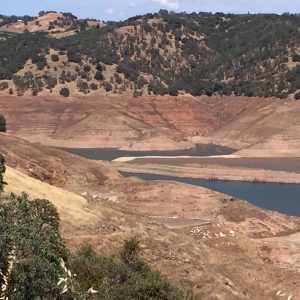The Life Cycle of Foothill Native Plants
Understanding the “Sleeping Beauty Syndrome” is important to gardening successfully with many California native plants. Their life cycle includes a period of summer dormancy which is broken by the kiss of the first rains of fall.
This is markedly different from the natural cycle of many of the eastern or British garden plants with which we are familiar. In their natural settings, winter often offers up the kiss of death, not of renewal.
Plants native to Mediterranean regions, like the coastal and chaparral plants of California, have had to develop mechanisms to survive heat stress. Their foliage consists of evergreen schlerophyll leaves—tough and leathery—often protected by waxy cuticle or surface hairs to resist. They toughen up in the summer, their aromatic oils or resins concentrating to repel grazing animals. Their metabolism slows down, reducing both new growth and loss of moisture by transpiration.
The new growing season starts in fall, rather than spring. When the first rains bless the land, the coats of fallen seeds begin to swell and split. Sensing the renewing moisture, the roots of perennials and shrubs begin vigorous new growth. While the nights may begin to feel chilly, the ground retains residual warmth from the summer. In the garden, we can simulate the early rains by beginning to water as early as mid-September to hasten the start of the growing season. I symbolically welcome the new season on the first day of fall, rains or not, by planting perennial seeds and beginning any new landscape planting that needs to be done.
The results of this early growth phase may not be immediately visible. Foliage may brighten, but tender new growth doesn’t push until after the serious cold snaps of December. With February’s early warm spell, the effects of that wonderful fall root growth become obvious. Plants freshen and grow rapidly, flowering early and vigorously.
I find that the main jobs in the spring are not to plant, but to maintain the drip irrigation system, do a little (or a lot) of weeding and renew the mulch around the plants.
Our aesthetic in gardening is to enjoy the forms and foliage of a plant, and especially to appreciate its flowering. However, the plant has a different goal. Its whole agenda is directed toward the production of its seeds. The flower is the means by which the plant goes toward maturing the seeds. Then, job done, the perennial plant can rest, and the annual fades and dies.
This rest occurs during the hot summer. The plant often sheds some of its foliage to reduce the amount of moisture it loses. Leaves toughen, often taking on a waxy or dull cast, becoming more resinous and less appealing to browsers.
It is important to respect this process in the garden, to be sparing with summer water and fertilization. Allow your plants to toughen up. Less tender new growth means less deer damage, less cleanup and pruning, and longer-lived plants. This is the time also to do a little deadheading or trimming. Perennials should have spent seed stalks removed, shrubs can be tip pruned.
As we look forward to a long summer, it is important not to overwater. These plants are native to the Mother Lode because they have evolved in our hot, dry summers and cool, snowy winters. Overwatering in the summer undoes this very important cycle for our native plants.
Mary Anderson, retired owner of Lost Hills Nursery, has spent the last 30 years getting to know California native plants on her 10-acre property and propagates many native plants from the seeds of her ‘mother plants’. She is one of the original members of the Sierra Foothills Chapter of the California Native Plant Society.

